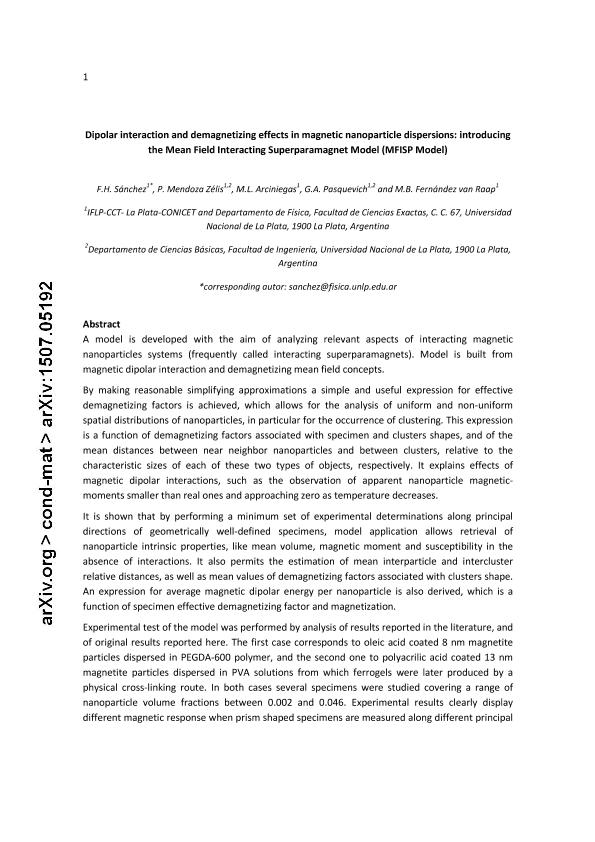Artículo
Dipolar interaction and demagnetizing effects in magnetic nanoparticle dispersions: Introducing the mean-field interacting superparamagnet model
Sánchez, Francisco Homero ; Mendoza Zélis, Pedro
; Mendoza Zélis, Pedro ; Arciniegas Vaca, Magda Lorena
; Arciniegas Vaca, Magda Lorena ; Pasquevich, Gustavo Alberto
; Pasquevich, Gustavo Alberto ; Fernández van Raap, Marcela Beatriz
; Fernández van Raap, Marcela Beatriz
 ; Mendoza Zélis, Pedro
; Mendoza Zélis, Pedro ; Arciniegas Vaca, Magda Lorena
; Arciniegas Vaca, Magda Lorena ; Pasquevich, Gustavo Alberto
; Pasquevich, Gustavo Alberto ; Fernández van Raap, Marcela Beatriz
; Fernández van Raap, Marcela Beatriz
Fecha de publicación:
04/2017
Editorial:
American Physical Society
Revista:
Physical Review B
ISSN:
2469-9969
Idioma:
Inglés
Tipo de recurso:
Artículo publicado
Clasificación temática:
Resumen
Aiming to analyze relevant aspects of interacting magnetic nanoparticle systems (frequently called interacting superparamagnets), a model is built from magnetic dipolar interaction and demagnetizing mean-field concepts. By making reasonable simplifying approximations, a simple and useful expression for effective demagnetizing factors is achieved, which allows the analysis of uniform and nonuniform spatial distributions of nanoparticles, in particular the occurrence of clustering. This expression is a function of demagnetizing factors associated with specimen shape and clusters shape, and of the mean distances between near neighbor nanoparticles and between clusters, relative to the characteristic sizes of each of these two types of objects, respectively. The model explains effects of magnetic dipolar interactions, such as the observation of apparent nanoparticle magnetic moments smaller than real ones and approaching to zero as temperature decreases. It is shown that by performing a minimum set of experimental determinations along principal directions of geometrically well-defined specimens, model application allows retrieval of nanoparticle intrinsic properties, like mean volume, magnetic moment, and susceptibility in the absence of interactions. It also permits the estimation of mean interparticle and intercluster relative distances, as well as mean values of demagnetizing factors associated with clusters shape. An expression for average magnetic dipolar energy per nanoparticle is also derived, which is a function of specimen effective demagnetizing factor and magnetization. Experimental test of the model was performed by analysis of results reported in the literature and of original results reported here. The first case corresponds to oleic-acid-coated 8-nm magnetite particles dispersed in PEGDA-600 polymer, and the second one to polyacrilic-acid-coated 13-nm magnetite particles dispersed in PVA solutions from which ferrogels were later produced by a physical cross-linking route. In both cases, several specimens were studied covering a range of nanoparticle volume fractions between 0.002 and 0.046. Magnetic response is clearly different when prism-shaped specimens are measured along different principal directions. These results remark the importance of reporting complete information on measurement geometry when communicating magnetic measurement results of interacting magnetic nanoparticles. Intrinsic nanoparticle properties as well as structural information on particles spatial distribution were retrieved from our analysis in addition to, and in excellent agreement with, analysis previously performed by other authors and/or information obtained from FESEM images. In the studied samples, nanoparticles were found to be in close contact to each other within almost randomly oriented clusters. Intercluster mean distance, relative to cluster size, was found to vary between 2.2 and 7.5, depending on particles volume fraction.
Archivos asociados
Licencia
Identificadores
Colecciones
Articulos(IFLP)
Articulos de INST.DE FISICA LA PLATA
Articulos de INST.DE FISICA LA PLATA
Articulos(INTEMA)
Articulos de INST.DE INV.EN CIENCIA Y TECNOL.MATERIALES (I)
Articulos de INST.DE INV.EN CIENCIA Y TECNOL.MATERIALES (I)
Citación
Sánchez, Francisco Homero; Mendoza Zélis, Pedro; Arciniegas Vaca, Magda Lorena; Pasquevich, Gustavo Alberto; Fernández van Raap, Marcela Beatriz; Dipolar interaction and demagnetizing effects in magnetic nanoparticle dispersions: Introducing the mean-field interacting superparamagnet model; American Physical Society; Physical Review B; 95; 13; 4-2017; 1-18; 134421
Compartir
Altmétricas



